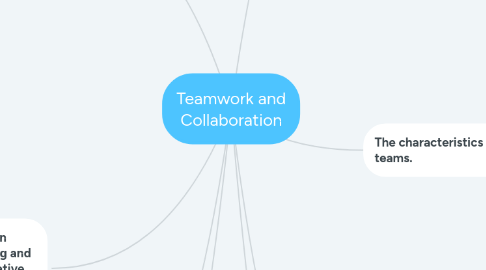Teamwork and Collaboration
by kelsey miller


1. The benefits and challenges of collaboration.
1.1. Benefits
1.1.1. Integration
1.1.2. Pronmotes empathy
1.1.3. improve teacher effectiveness
1.1.4. Classroom activites more manageable
1.1.5. Bounce ideas
1.1.6. Create a shared vision
1.1.7. Community sense of belonging
1.1.8. improve students success
1.1.9. Out of box thinking
1.2. Challenges
1.2.1. Possible conflicts with individuals
1.2.2. uneven workloads
1.2.3. Closed off on sharing views
1.2.4. Experienced teachers not listening to others ideas
1.2.5. New teachers not voicing their ideas or opinions.
2. The role of leadership in establishing, supporting and maintaining a collaborative culture within an educational organization.
2.1. Open communication dialogue
2.2. Create leadership groups
2.3. Promote and encourage leadership roles
2.4. Role-model
2.5. Authentic Listening
2.6. Communication skills
2.7. Understanding of others feelings /body language
2.8. Sharing of knowledge
2.9. Continued collaboration with all
3. Team Norms
3.1. Highly functioning
3.2. Collaboration
3.3. Teams flow
3.4. Precise goal and commitment to one another
4. Response to Intervention
4.1. 3-tiered program
4.2. Gives students and opportunity to learn at grade level
4.3. Prevents a problem from getting worse
4.4. RTI are used in special education and students with behavior issues
5. The potential impact of effective collaborative teams on teaching, learning and increasing student achievement of learning.
5.1. Psychological safe teams (Zimmerman, D. P., Roussin, J. L., & Garmston, R. J., 2020)
5.1.1. Experiment ideas together
5.1.2. Discuss Mistakes with one another
5.1.3. Share Ideas to each other
5.1.4. Ask for and receive feedback

